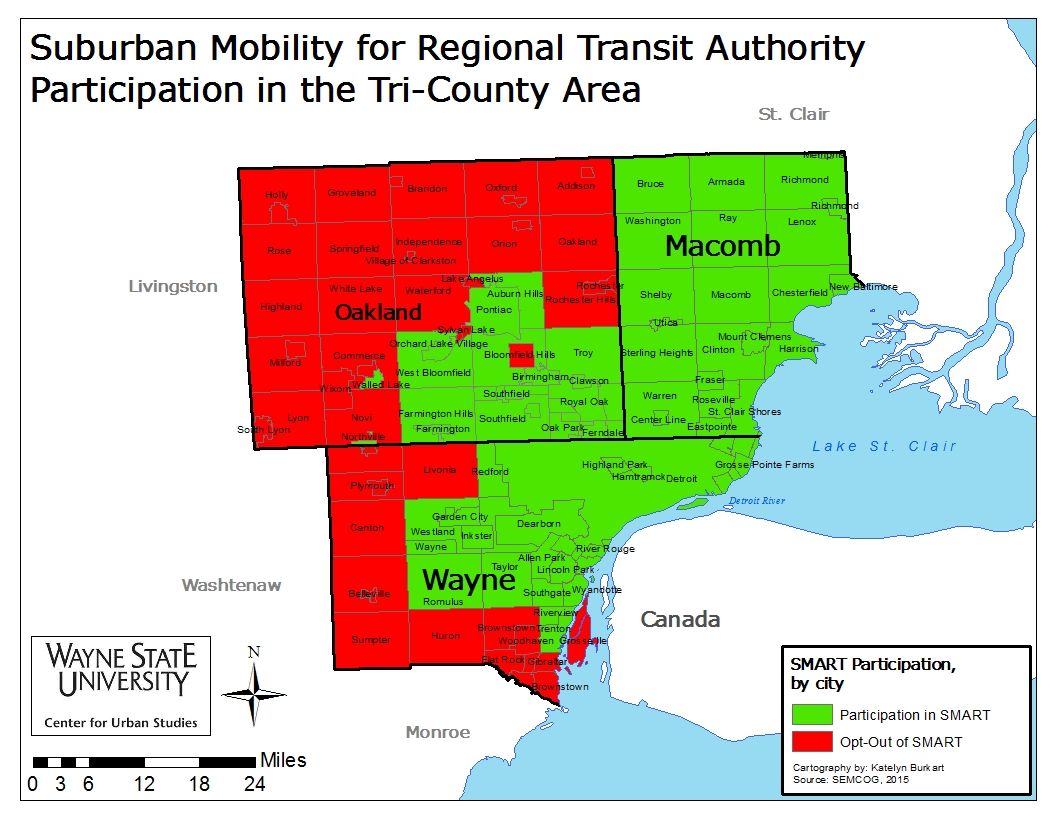In our last two posts we discussed several regional authorities that governments and voters in Southeast Michigan have approved, especially in the wake of Detroit’s financial problems. In this post, we will consider regional efforts to coordinate and fund mass transportation in the area. Transportation planning in Metro-Detroit has long been a fragmented issue. Currently, the Regional Transportation Authority (RTA), which was created through Public Act 387 of 2012, is placing the finishing touches on its Regional Master Plan. This plan is to include main transportation routes along Woodward, Gratiot and Michigan avenues, along with connector lines going east to west throughout Wayne, Oakland, Macomb and Washtenaw counties. It is these four counties that the RTA encompasses and, in order to have sufficient funding for a robust regional transportation system, the RTA is expected to put a ballot initiative before the voters of these four counties (Detroit included) asking for a yet-to-be-determined amount of funding through a millage. According to Public Act 387 of 2012, the RTA can receive money through voter approved millage funding and/or an additional fee that may accompany state driver registration fees. Ballot initiatives can only be placed on ballots during presidential or gubernatorial elections.
Decisions on how and when to seek public funding are made through the RTA’s Board of Directors. This is a 10-member Board, with each Board member serving three-year terms. The County Executives of Wayne, Oakland and Macomb counties each appoint two board members, the Chair of the Washtenaw County Board of Commissioners appoints two members, the Mayor of Detroit appoints one member and the Governor appoints one member. The Governor’s appointee serves as chair but does not vote, according to the RTA’s website.
Prior to the establishment of the RTA, the Suburban Mobility Authority for Regional Transit (SMART) was created in 1967, and it still operates in portions of Wayne, Oakland and Macomb counties. Up until recently, SMART did not coordinate with the Detroit Department of Transportation (DDOT), and because of the way SMART initiatives can be placed on the county ballots (by individual counties), Macomb County is the only county in which all communities support the suburban transit authority and are all thereby affected by the authority’s ballot initiatives. In Oakland and Wayne counties, communities have the option to “opt-out” of supporting the authority.
The percentage of opt-out communities as of February 2015 was as follows:
- Wayne County: 38.6%
- Oakland County: 57.6%
- Macomb County: 0%
Most recently, the County Board of Commissioners in Wayne, Oakland and Macomb counties placed a 4-year 1 mill request for the Suburban Mobility Authority for Regional Transit (SMART) on the ballot in August of 2014. The 1 mill request, which included an increase from the original 0.59 mills, was approved throughout the tri-county region as follows:
- Wayne County: 63.45% yes
- Oakland County: 73.6% yes
- Macomb County: 59.6% yes
While SMART, RTA, DDOT and the Ann Arbor Transportation Authority (AATA) are now expected to coordinate with one another, it has taken about 100 years for the region to develop even a semblance of a coordinated regional transit system.
Starting with streetcars in the early 1900s, Southeastern Michigan once had the largest transportation system in the country, according to Tobi Voigt of the Detroit Historical Society in a 2015 Detroit Free Press article. Although the streetcars were once nearly all privately owned, in 1922 the voters of Detroit voted to buy the streetcars, lines and all other materials that made them operational at a cost of $19.8 million. Having bought an aging system, and then with the Great Depression and World War II, the once vibrant streetcar system could no longer be maintained with the funds the city had. The aging infrastructure, however, did not deter people from using the system. According to Voigt, during World War II ridership actually doubled because of widespread difficulty in obtaining gas, tires and vehicles during World War II.
While World War II meant increased ridership, post-World War II meant the beginning of a more developed highway system and more wealth to afford vehicles. These societal changes lead to the retirement of Detroit’s last streetcar on April 8, 1956.
Following streetcars came busses, a mode of transportation still used today. Similar to today’s operations, the DDOT (formerly the Detroit Department of Street Railways) attempted to coordinate with a regional entity—then called the Southeastern Michigan Transportation Authority (SEMTA). Created by the Michigan Legislature in 1967, SEMTA was intended to provide service to the seven county region. However, SEMTA did not have the authority to ask voters for operating funds. This, combined with decreasing ridership and President Ronald Reagan’s decision to cut federal funding to regional transit authorities in 1985, caused SEMTA to cut down to bare bones operations. By 1989, SEMTA became SMART, an authority with the power to seek millage funding.
With its 2012 creation, the RTA is now the entity charged with coordinating and planning for public transportation in Wayne, Oakland, Macomb and Washtenaw counties; applying for state and federal transportation dollars; and dispersing those dollars to the appropriate entities.
Despite the RTA’s status as the “official” regional transportation authority, collaboration between it, SMART, DDOT and the AATA is expected to take place so truly robust, connected and coordinated system can exist.
Regionalism never strongly existed in the Metro-Detroit area until the financial downfall of Detroit began, and even though we are now seeing a surge in regional coordination, the coordination between those regional entities remains fragmented.
